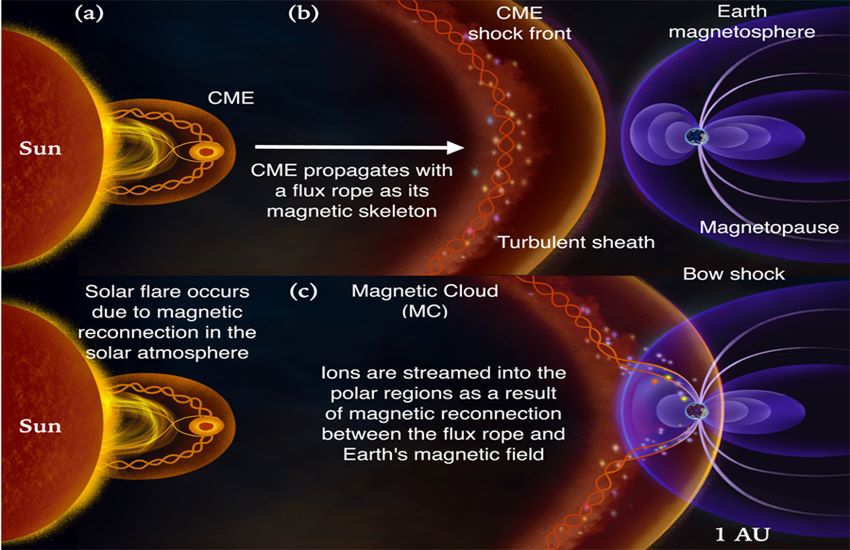Solar Propagation

The drawing above represents the Sun’s coronal mass ejection (CME) propagation life-cycle. (a) Initially, the solar flare occurs and the CME is launched near the solar surface as a result of magnetic reconnection. (b) The CME propagates in the interplanetary space (ICME) toward the Earth with the magnetic flux rope as its core. The turbulent sheath forms behind the CME shock front and reaches the Earth in advance of the MC. (c) As a result of reconnection between the flux rope and Earth’s magnetic field, the heavily ionized ions are streamed into the magnetosphere, particularly to the polar regions, along the magnetic field lines.
Solar Disturbances that Affect Radio Propagation: Solar Wind, Solar Flares, & CMEs
The condition of the Sun has influence on ionospheric radio propagation, and solar disturbances like Solar Wind, Solar Flares, and Coronal Mass Ejections have a major impact. It is primarily radiation from the Sun that gives rise to Earth’s ionosphere. As a result, the Sun has a huge impact on the state of the ionosphere and in turn the conditions for radio propagation.
These affect a variety of forms of RF communications including two way radio communications, maritime mobile radio communications, general mobile radio communications using the HF/VHF/UHF bands, point to point radio communications, radio broadcasting and amateur radio communications.
- Solar Wind: Under steady conditions the Sun emits a constant stream of material: plasma. This is a very hot and ionized stream of material, that the Sun emits in all directions. This is called the Solar Wind, and it travels at speeds between about 300 and 800 km/s. The actual source of the Solar Wind is the Corona where the temperature is so high and material so excited by this that the gravitational forces of the Sun are overcome and material escapes.
Some of the solar wind naturally reaches the Earth and is mainly deflected by the Earth’s magnetic field. When the solar wind is very high, this can lead to visible auroras and geomagnetic and ionospheric storms which impact all RF communication transmissions.
-
Solar Flares: Solar flares are enormous explosions that occur on the surface of the Sun. They result in the emission of colossal amounts of energy. In addition to this, the larger solar flares also eject large amounts of material mainly in the form of protons. The flares normally occur near sunspots, often along the dividing line between them where there are opposed magnetic forces.
When this occurs an eruption of gases takes place through the solar surface, and it extends several tens of thousands of miles out from the surface of the Sun and follow the magnetic lines of force to form a solar flare. The gases from within the sun start to rise and the area becomes heated even more and this causes the level of visible radiation and other forms of radiation to increase.
| Solar Flare Classifications | |
| Flare Classification | Details |
| X Class | X-class is the classification for the largest flares; these are major events that can trigger Ionospheric radio propagation blackouts around the whole world and long-lasting radiation storms in the upper atmosphere. |
| M Class | M-class flares are a tenth the size of X-class and are described as being medium-sized. They generally cause brief radio blackouts that affect Earth's polar regions and sometimes minor radiation storms follow. |
| C Class | C-class flares are small and they give rise to very few noticeable consequences on Earth. At its peak, a C-class flare is a tenth of the size of M-class. |
| B Class | B-class flares are a tenth the size of C-class. Near zero impact on Earth or radio communications. |
| A Class | A-class flares are a tenth of the size and intensity of B-class. They have no noticeable impact on Earth or radio communications. |
Effects of Solar Flares
The radiation from the flare covers the whole electromagnetic spectrum and elements such as ultra-violet and X-rays will affect the levels of ionization in the ionosphere and has an effect on radio communications. Often an improvement in ionospheric HF propagation is noticed as the higher layers of the ionosphere have increased levels of ionization.
However, if the levels of ionization in the lower levels start to rise then this can result in higher levels of attenuation of radio communication signals, degrading conditions. An increase in the level of background noise at VHF may also be detected.


